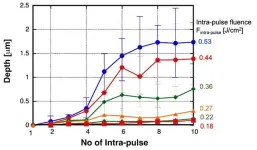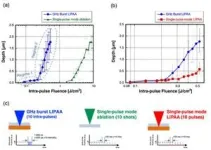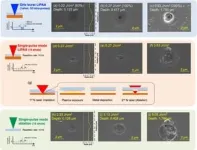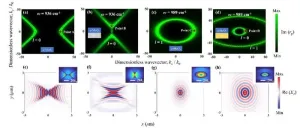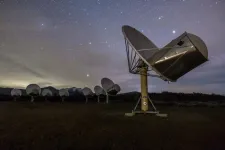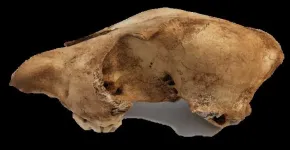A new publication from Opto-Electronic Advances; DOI 10.29026/oea.2024.240029 , discusses super-resolution machining of single crystalline sapphire by GHz burst mode femtosecond laser-induced plasma assisted ablation.
GHz burst-mode femtosecond (fs) laser, which emits a series of pulse trains (burst pulse) with extremely short intervals of several hundred ps, offers distinct characteristics in materials processing as compared with conventional fs laser (single-pulse mode). The authors of this article have demonstrated that the GHz burst mode fs laser greatly improves ablation efficiency, quality and speed. GHz burst mode fs laser was further applied to surface nanostructuring, showing formation of unique two-dimensional (2D) periodic surface structures different from 1D structures fabricated by the single-pulse mode. The authors took advantage of the distinct features of GHz burst mode fs laser for super-resolution machining of single crystalline sapphire by this original technique termed laser induced plasma assisted ablation (LIPAA). The single crystalline sapphire is an attractive material for a variety of industrial applications due to its excellent characteristics such as high-transparency in a visible range, high hardness, and good thermal resistivity. However, the excellent characteristics make high-quality, high-precision processing of sapphire difficult. In the LIPAA process, a substrate that is transparent to the laser beam is placed on a metal target such as copper. The interaction of laser beam and plasma generated from the target performs high efficiency ablation of the rear surface of transparent materials. GHz burst mode fs laser LIPAA enables direct interaction of the plasma induced by the preceding laser pulses with the subsequent laser pulses due to the moderate interval of each pulse in the burst pulse, achieving higher ablation efficiency and quality as well as better fabrication resolution. Thus demonstrating the potential of GHz burst mode fs-LIPAA for high-quality, high-efficiency microfabrication of single crystalline sapphire substrates.
GHz burst-mode fs laser emits a series of pulse trains with extremely short intervals of several hundred ps. Here, the single pulse train is called burst pulse and each pulse in the burst pulse, intra-pulse. In their experiments, a single crystalline sapphire substrate was placed in contact with a copper target, and a single burst pulse was irradiated to the copper target through the sapphire substrate. The moderate pulse interval in the GHz burst pulse could enable direct interaction of the subsequent laser pulses with plasma generated by the preceding laser pulses at the interface of sapphire substrate and copper target.
For the GHz burst LIPAA process, the ablation depth depends on the intra-pulse fluence, and the number of intra-pulses, P (Fig. 1). Naturally, variations of ablation depth on intra-pulse energy show that the higher intra-pulse fluence leads to increase of the ablation depth. Importantly, the ablation depth drastically increases at the intra-pulse number of 5. The time interval between 1st intra-pulse and 5th intra-pulse is about 1 ns. The reason for the drastic increase in ablation depth is thought to be that the plasma density becomes high enough to contribute LIPAA process at around 1 ns after the 1st intra-pulse irradiation. Specifically, in case of Cu ablation, it is known that generation of the laser-induced plasma starts from 10-50 ps after the laser pulse irradiation, and its density is then maximized at around 1 ns, at which 5th pulse can efficiently interact with the plasma to drastically increase the ablation depth.
The authors further found that the ablation threshold decreases to 1/7.3 as compared with the single-pulse mode fs laser direct ablation (Fig. 2 (a)). In addition, the ablation depth was increased by a factor of 4.2 - 5.0 compared to that by the single-pulse mode LIPAA (Fig. 2(b)). Importantly, the increased absorption further allowed achieving much better ablation quality. Furthermore, the GHz burst mode LIPAA process improves the fabrication resolution far beyond the focused laser spot size due to the synergetic contribution of threshold effect and higher plasma density closer to the center of laser beam (Fig. 3). Thus, it can be concluded that the GHz burst mode LIPAA process provides the ability to realize micro- and nanofabrication of sapphire with high processing efficiency, high processing quality, and high fabrication resolution. This process can be further extended to processing of other transparent materials. The use of shaped beams such as Bessel beam and vector beam will enhance the performance of LIPAA in terms of fabrication geometry, resolution and efficiency.
Keywords: monolayer TMD / WS2 / 2D-derived quantum dots / UV absorption / energy transfer
# # # # # #
The research team of authors focus on research and development of advanced laser processing which realizes low environmental load, high quality, high efficiency, high resolution fabrication of materials. Specifically, by using ultrafast lasers, novel material processing that cannot be achieved by the other conventional techniques is developed. The recent research topics to be developed include three-dimensional micro/nanofabrication, high aspect ratio machining, and surface nanostructuring, which are applied for fabrication of biochips, ultrahigh sensitive sensors, and high function photonic and electronic microdevices.
# # # # # #
Opto-Electronic Advances (OEA) is a rapidly growing high-impact, open access, peer reviewed monthly SCI journal with an impact factor of 14.1 (Journal Citation Reports for IF2022). Since its launch in March 2018, OEA has been indexed in SCI, EI, DOAJ, Scopus, CA and ICI databases over the time, and expanded its Editorial Board to 30 members from 17 countries.
The journal is published by The Institute of Optics and Electronics, Chinese Academy of Sciences, aiming at providing a platform for researchers, academicians, professionals, practitioners, and students to impart and share knowledge in the form of high quality empirical and theoretical research papers covering the topics of optics, photonics and optoelectronics.
# # # # # #
More information: http://www.oejournal.org/oea
Editorial Board: http://www.oejournal.org/oea/editorialboard/list
All issues available in the online archive (http://www.oejournal.org/oea/archive).
Submissions to OEA may be made using ScholarOne (https://mc03.manuscriptcentral.com/oea).
ISSN: 2096-4579
CN: 51-1781/TN
Contact Us: oea@ioe.ac.cn
Twitter: @OptoElectronAdv (https://twitter.com/OptoElectronAdv?lang=en)
WeChat: OE_Journal
# # # # # #
Sharbirin AS, Kong RE, Mato WB et al. Highly enhanced UV absorption and light emission of monolayer WS2 through hybridization with Ti2N MXene quantum dots and g-C3N4 quantum dots. Opto-Electron Adv 7, 240029 (2024). doi: 10.29026/oea.2024.240029
END
